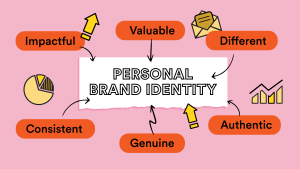4 Personal Branding
Until you’ve lost your reputation, you’ll never realise the true value of good branding
Stacey Kehoe, Founder and Director of Communications, Brandlective Communications
 Learning Objectives
Learning Objectives
On completion of this chapter you should be able to:
- Understand that personal branding is a process and a product and consists of values, drivers, reputation, behaviours, skills and image.
- Develop strategies for increasing your social capital.
- Appraise why personal branding can have positive outcomes in increasing prestige, visibility, monetary gains, self-awareness, and sensemaking.
- Reflect on your desired professional image and your perceived professional image for congruence or discrepancy.
- Translate the theoretical knowledge provided into a set of strategies for improving your personal brand.
Introduction
Personal branding has become an integral part of the career management debate. There are many reasons for this, not least, the ready access to social media. However, a fundamental driver has been the shift in careers. As we’ve seen in previous chapters, evidence suggests that fewer people are employed in organisations as the gig economy gains traction, and large corporations downsize as technology progresses and firms require fewer workers. Additionally, there are no ‘jobs for life’, as was the norm until the middle of the twentieth century. It is suggested that young people today will have 18 different jobs and six different careers in their lifetime (The Foundation for Young Australians, 2020). A consequence of the above is that the responsibility for managing careers has moved from organisations to individuals. Even for staff that do continue to work for organisations, there are still multiple career transitions, either internally through re-structures, or externally as you move on for various reasons.

Figure 4.1 ‘Personal brand‘ Peggy Marco, 2015. Used freely from Pixabay.
So, What is a Personal Brand?
Think about when you meet someone for the first time. We take less than a second (390 milliseconds to be precise) to form an impression of someone’s personality based on their voice and other attributes (Bar et al. 2006; Thomson, 2014). Peters, in a 1997 FastCompany article said:
We are CEOs of our own companies: Me Inc. To be in business today, our most important job is to be head marketer for the brand called You.
I think that might be taking it at least one step too far, but with the gig economy and multiple career transitions leading to work decontextualization, people need to construct their professional work identities and a strong coherent personal brand may help people do this. Managing your personal brand is arguably more important now than ever before, indeed, the Personal Branding Group say that personal branding is not an option.
Personal branding can be thought of as both a product and a process. The scholarly literature on personal branding is in its infancy but Gorbatov et al. (2018) offer the following definition of a personal branding product:
Personal branding is a set of characteristics of an individual (attributes, values, beliefs, etc.) rendered into the differentiated narrative and imagery with the intent of establishing a competitive advantage in the minds of the target audience.
Holloway (2013) notes that a personal brand consists of values, drivers, reputation, behaviour, skills and image and that everything we do affects our personal brand, including:
- The way we talk, walk and dress.
- Our education and class.
- The way we negotiate and meet our obligations.
- Our customer service and presentation skills.
- How we follow through on our promises.
The first two of these points are related to how we ‘fit in’ to the environment. Every organisation and often every department within an organisation, has their own culture. Acquiring the correct social and cultural capital is critical for our career success. If you do not sign up to the organisation’s expectations, the embedded culture acts as a gatekeeper, keeping out those who challenge the status quo and only letting those that fit through that gate and onto better roles. This can be seen in practice through the dearth of minority staff in senior management roles in most organisations – women, people of colour, differently abled, and LGBTIQ+ (Gander, 2022).
Gorbatov et al. (2018) also suggest that personal branding is a process undertaken to create the final product:
Personal branding is a strategic process of creating, positioning, and maintaining a positive impression of oneself, based in a unique combination of individual characteristics, which signal a certain promise to the target audience through a differentiated narrative and imagery.
The question arises, why should I care about developing a personal brand, what are the outcomes for me?
 Watch a short clip of our industry expert, Sean Tierney, talking about personal branding.
Watch a short clip of our industry expert, Sean Tierney, talking about personal branding.
There are both intrinsic and extrinsic outcomes for you as an individual. For example, extrinsic outcomes include furthering your professional career, increasing social capital, visibility, prestige, differentiation and monetary gain. Intrinsic benefits, arguably more important for the long-term, include sensemaking, self-awareness, career motivation, self-realisation, credibility, influence, and self-promotion skills (Gorbatov et al., 2018). Interestingly, there are positive outcomes for organisations too, including increased retention and productivity as employees who are credible and authentic have increased work satisfaction and higher task engagement (Roberts, 2005).
Personal brand as a product
People in a work situation will unconsciously form opinions about you. These opinions will be either positive, negative, or neutral. Your personal brand is intricately linked to your reputation and is made up of your biography, experience, skills, behaviours, appearance, and your name (James 2009).

Figure 4.2 ‘Key traits for personal brand identity’ © Michelle Gander, 2023. CC BY-NC 4.0.
The literature points to several key factors to having a good personal brand (Montoya and Vandehey, 2003; Chan, 2018)
- You are different.
- You are better.
- You are authentic.
- You are genuine.
- You are consistent.
- You create a positive impact.
- You live your brand.
The idea of managing our personal brand is the process of taking all of the above and packaging these attributes into an identity that gives us that added je ne sais quoi above our competitors (for projects, jobs, promotions, etc.) – our desired professional self. Our personal brand then is the perception that comes to mind whenever people think of us – the perceived professional self. To start to define and therefore manage your personal brand, you need to understand what your current personal brand is.je ne sais quoi
 Watch our industry expert, Sean Tierney, discuss the need for your personal brand pitch and authenticity.
Watch our industry expert, Sean Tierney, discuss the need for your personal brand pitch and authenticity.
Creating your Personal Brand
Personal branding comprises two key elements as first outlined by Roberts (2005): your desired professional image and your perceived professional image – how you as an individual want to be perceived and how in reality your personal brand is perceived (see Fig. 4.3). As Gandini (2016) noted you need to clearly understand what you intend to project to your target audience and then, that audience’s reaction to it.

Figure 4.3 ‘Your perceived versus your desired professional image’ © Michelle Gander, 2023. CC BY-NC 4.0.
To start the process of personal branding, you need to reflect on your current brand. See Exercise 4.1 to get started on this process. This exercise is encouraging you to undertake reflective practice. Simply put, it involves you thinking about what you do, to understand how other people see you. The difference in this way of reflecting is that compared to how we normally think, reflective practice requires a more conscious effort to develop an insight. Reflective practice is learning through and from your own experiences, moving towards the gaining of new insights. As this often involves examining assumptions about everyday practice it should be a valuable tool to use to reflect on our personal brands (see Fig. 4.3).
 Exercise 4.1
Exercise 4.1
Ask yourself the following questions in your work or educational context and be as honest as you can be!
- What do people think of me?
- If I had to choose three words to describe myself at work, what would they be?
- What’s my reputation?
- What do people say or think about you when you’re not in the room?
- Are you consistent?
- Do you always meet your promises?
The first step in this process is to gather feedback from others. This can be difficult but is critical in terms of seeing if there is congruence between your desired and your perceived self-image. There are many ways to do this. If you are currently a student then you could ask a variety of different people such as your lecturers, acquaintances, or work colleagues, if you have them. Try not to ask your close friends because they will probably not be able to be objective in their answers. If you do already work in an organisation then perhaps your human resource department has a 360° feedback tool. This is where you answer a set of questions about you and your behaviours at work, and then you identify several colleagues to do the same, normally one is your manager and if you lead a team, one will be a team member. The trick here is to be brave and choose people who are not automatically going to give you ‘excellent’ in each area.
Re/Constructing your Personal Brand
James (2009) suggests starting to develop your personal brand by writing a statement of purpose. This statement guides you on how to manage your brand and acts as a filter for decisions that you make that deliver on your brand. For example, as a Dean (People & Resources) at a university, my purpose statement is:
To ensure a successful College, I will work as a conduit between the senior management of the University and staff in the College, to ensure organisational success through a culture of inclusion and support.
The second step is to determine your beliefs and unique take on the world in relation to your purpose, so again, mine would be:
I believe the world would be a better place if organisations supported and developed their staff to allow them to attain their work-related needs and ambitions.
The third step is to reflect on your principles so:
I will only work for organisations that truly value their staff.
Personal brands take time to develop. We can put the attributes into place, but it develops at its own pace; it is a long-term strategy. Brands grow organically, the best personal brands develop as a result of strong communication, a sense of purpose, and the person behind the brand backing up the brand’s promise again and again. Brands demand consistency and clarity, a strong brand can withstand some shocks to the system but too much inconsistency or ‘failure’ leads to a rapid decline in brand status. Now that we have our brand strategy how do we go about developing it, or re-developing it, what are the different tactics we can use? If we re-visit the list of key factors outlined above, how can we ensure that we are different, better, authentic, genuine, consistent, and have a positive impact? Gander (2014) notes that there are seven activities to construct your positive personal brand.
Work hard: I’m afraid there is no getting away from the first one! You must work hard. I don’t mean long hours here, I mean when you’re at work, you’re at work so to speak. You need to get noticed and you need to know what skills to develop to get where you want to be. Nothing says more about your brand than achieving results. As those in the sports world know particularly well, results come from consistent work over years, not one amazing training session.
Do work no-one else wants to (sometimes): There are lots of opportunities to take on a bit extra work here and there from project managing to committee servicing, to being involved with recruitment. However, related to this is also knowing when to say ‘no’. Understanding that some additional tasks can give you experience and new skills and that helping other people in the organisation is good, being overwhelmed with work to the point that you stop achieving results is obviously detrimental. Strike that balance.
Learn one new skill every few years: Choose one new skill that will benefit your ambitions and make a commitment to become an expert in it. If it’s a technology-related skill all the better as most people hate new tech! Can you become the expert in data analytics, or productivity tools? How about change management?
Sharpen your narrative: When people ask you ‘what have you been up to lately?’ (this happens a lot before meetings begin), Clark (2014) says we should not waste the opportunity to promote ourselves. How many of us have said ‘oh, not much, the usual’? However, when developing and managing your personal brand take the opportunity to tell people something – you’ve been on a training course, you’ve written your latest blog post etc., or how your latest project is progressing. Self-promotion can be a bit nauseating if it’s really blatant but if someone asks then take the opportunity, you never know: it might lead to some more interesting discussions and collaborations.
Network: You should not think of networks in a purely transactional way – the best networks are reciprocal. When you meet new people, seek them out on LinkedIn and other social media platforms, and share ideas. Grant (2013) wrote about ‘dormant ties’, those people you used to know but haven’t been in touch with for a good while. In the time that you haven’t talked to them they will have made new connections and networks and if you rekindle the link they will share these with you; you can then return the favour.
Use social media: Social media is now integral in personal branding, and a good social media profile can enhance your brand, especially in a job-seeking phase. As a Gen Xer, I didn’t grow up with social media but I was an early adopter of many of the different platforms. However, I acknowledge that the way I use social media is inherently different to Millennials and Gen Zers. I have quite a transactional relationship with social media – I use it professionally (LinkedIn), or socially (Instagram, although barely). Research has shown that Gen Zers tend to build their brands by using Instagram, perhaps as a result of the influencer impact (Vițelar, 2019). However, for a profession-based personal brand, individuals do need to go past Instagram, and everyone should have a LinkedIn account. Research has shown that for top executives, a well-planned personal brand strategy creates value for them and their organisations by gaining customers, awareness, and loyalty (Karaduman, 2013).
Social media offers the ability to manage many more peripheral connections than can be managed face-to-face and certainly helps if you work across states or countries; social media also help you to share and promote your work to a wide audience. Needless to say, a professional work persona can be and should be created and managed online so that if someone Googles you, your professional identity is the first that is returned. To note, you must keep your profiles updated because 1) it is easier to do this regularly then when you decide you want to apply for a new job and you’ve forgotten everything you’ve done, 2) you never know who may stumble across your profile, especially recruiters, and 3) if you apply for a job, the recruitment committee will definitely look at your LinkedIn profile.
Personal image: Always a hard one this, but as they say clothes maketh the (wo)man (who first wrote this is debatable but makes for an interesting time spent down the Google rabbit hole!). If career success is what you’re after, you are going to have to conform to the embedded and culturally acceptable clothing style of your organisation. Some leeway can work, you can establish that you always wear red lipstick, big jewellery, crazy socks etc. Some people famously have their work ‘uniform’ – think about Apple’s late Steve Jobs and his jeans, trainers and black polo-necks. If you work in a more visual industry such as marketing or architecture, more personality in your work clothes is the norm. The rule in general is, look around you, and then decide, are you going to conform to the unspoken uniform, or are you forging your own path?
In Summary
You might not agree with the premise of taking concepts from marketing products and applying them to marketing yourself but arguably there is benefit in doing the activities above to establish your personal brand and/or improve your reputation and visibility. Ensuring that your brand is congruent with your values is key for a successful career and it has been shown that it increases your visibility, income, self-awareness and sense of self. Personal brand work must always be a work in progress and requires you to manage, for example, your social media presence and your networks to ensure continued congruence with who you are and what people think you are.
 Exercise 4.2
Exercise 4.2
Reflect on the questions / prompts below:
- Think about your answers for Exercise 3.1 and reflect on what these mean for you right now.
- Think about some ‘easy wins’ for managing your personal brand. For example, can you create a LinkedIn profile, can you do some form of 360° feedback?
- Consider if you have time to develop a new skill so you can add it to your CV through activities at your college/university.
 Key Takeaways
Key Takeaways
- Personal branding is critical for internal and external career outcomes.
- Personal branding is a process and a product.
- You need to actively review and manage your personal brand.
- Find your purpose, beliefs and principles.
- Manage social media to ensure a professional image.
References
- Bar, M., Neat, M. and Linz, H. (2006). Very first impressions. Emotion 6(2): 269–278. https://doi.org/10.1037/1528-3542.6.2.269.
- Chan, G. (2018). 10 Golden rules of personal branding. Forbes, 8 November 2018.
- Clark, D. (2014). Brand you 2014: five personal branding tips for the year ahead. The Guardian, 6 January 2014.
- Gander, M. (2014). Managing your personal brand. Perspectives: Policy and Practice in Higher Education, 18(3): 99–102. https://doi.org/10.1080/13603108.2014.913538.
- Gander, M. (2022). A holistic career framework: integrating Bourdieu and career theory. Australian Journal of Career Development 31(1), 14–25. https://doi.org/10.1177/10384162211070081.
- Gandini, A. (2016). Digital work: self-branding and social capital in the freelance knowledge economy. Marketing Theory 16(1), 123–141. https://doi.org/10.1177/1470593115607942.
- Gorbatov, S., Khapova, S. N. and Lysova, E. I. (2018). Personal branding: interdisciplinary systematic review and research agenda. Frontiers in Psychology. https://doi.org/10.3389%2Ffpsyg.2018.02238.
- Grant, A. (2013). Finding the hidden value in your network. LinkedIn, 17 June 2013.
- Holloway, J. (2013). Managing your Personal Brand. Webinar for Open University MBA alumni.
- James, B. (2009). The value of personal branding. The Gallup Management Journal, 23 July 2019. https://news.gallup.com/businessjournal/121796/value-personal-branding.aspx.
- Karaduram, I. (2013). The effect of social media on personal branding efforts of top level executives. Procedia – Social and Behavioral Sciences 99, 465–473. https://doi.org/10.1016/j.sbspro.2013.10.515.
- Montoya, P. and Vandehey, T. (2003). The Brand Called You. Personal Branding Press.
- Peters, Y. (1997). The brand called you. Fast Company, 31 August 1997.
- Roberts, L. (2005). Changing faces: professional image construction in diverse organizational settings. Academy of Management Review 30(4), 685–711. https://doi.org/10.5465/amr.2005.18378873.
- FYA. (2020). The new work standard: how young people are engaging with flexible work. The Foundation for Young Australians.
- Thomson, H. (2014). Your voice betrays your personality in a split second. New Scientist, 14 March 2014.
- Vițelar, A. (2019). Like me: Generation Z and the use of social media for personal branding. Management Dynamics in the Knowledge Economy 7(2), 257–268. https://www.managementdynamics.ro/index.php/journal/article/view/311/264.
Something (such as an appealing quality) that cannot be adequately described or expressed

